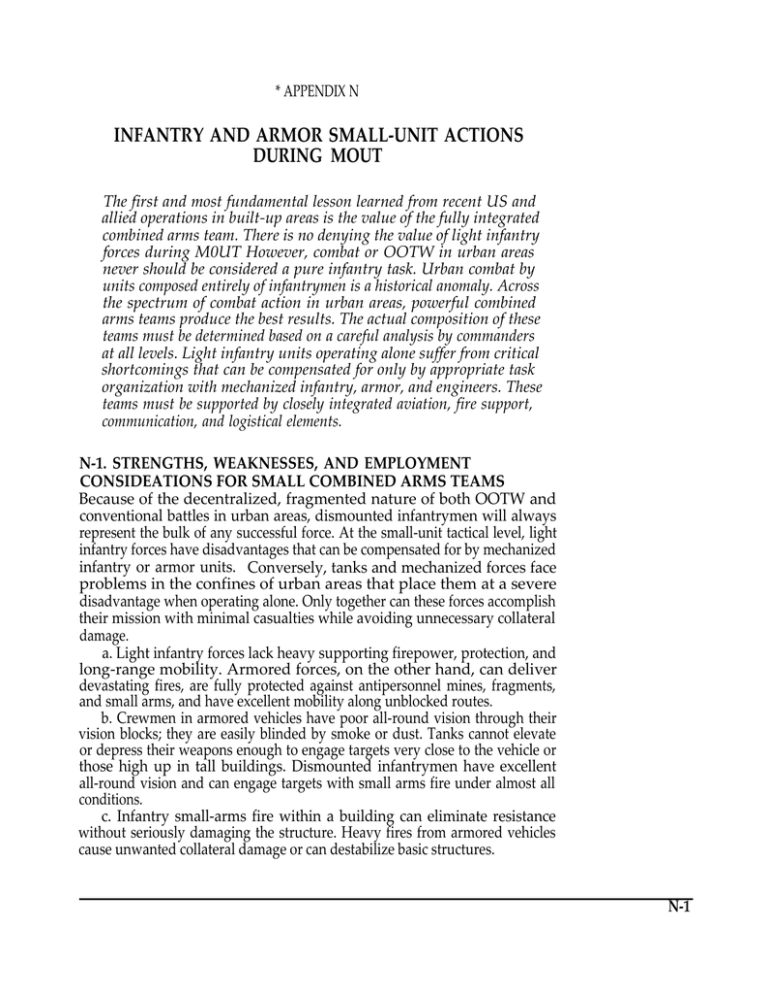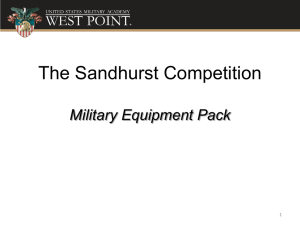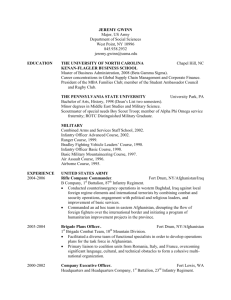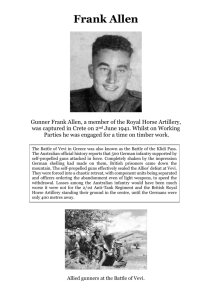INFANTRY AND ARMOR SMALL-UNIT ACTIONS DURING MOUT
advertisement

* APPENDIX N INFANTRY AND ARMOR SMALL-UNIT ACTIONS DURING MOUT The first and most fundamental lesson learned from recent US and allied operations in built-up areas is the value of the fully integrated combined arms team. There is no denying the value of light infantry forces during M0UT However, combat or OOTW in urban areas never should be considered a pure infantry task. Urban combat by units composed entirely of infantrymen is a historical anomaly. Across the spectrum of combat action in urban areas, powerful combined arms teams produce the best results. The actual composition of these teams must be determined based on a careful analysis by commanders at all levels. Light infantry units operating alone suffer from critical shortcomings that can be compensated for only by appropriate task organization with mechanized infantry, armor, and engineers. These teams must be supported by closely integrated aviation, fire support, communication, and logistical elements. N-1. STRENGTHS, WEAKNESSES, AND EMPLOYMENT CONSIDEATIONS FOR SMALL COMBINED ARMS TEAMS Because of the decentralized, fragmented nature of both OOTW and conventional battles in urban areas, dismounted infantrymen will always represent the bulk of any successful force. At the small-unit tactical level, light infantry forces have disadvantages that can be compensated for by mechanized infantry or armor units. Conversely, tanks and mechanized forces face problems in the confines of urban areas that place them at a severe disadvantage when operating alone. Only together can these forces accomplish their mission with minimal casualties while avoiding unnecessary collateral damage. a. Light infantry forces lack heavy supporting firepower, protection, and long-range mobility. Armored forces, on the other hand, can deliver devastating fires, are fully protected against antipersonnel mines, fragments, and small arms, and have excellent mobility along unblocked routes. b. Crewmen in armored vehicles have poor all-round vision through their vision blocks; they are easily blinded by smoke or dust. Tanks cannot elevate or depress their weapons enough to engage targets very close to the vehicle or those high up in tall buildings. Dismounted infantrymen have excellent all-round vision and can engage targets with small arms fire under almost all conditions. c. Infantry small-arms fire within a building can eliminate resistance without seriously damaging the structure. Heavy fires from armored vehicles cause unwanted collateral damage or can destabilize basic structures. N-1 C1, FM 90-10-1 d. If isolated or unsupported by dismounted infantry, armored vehicles (with the possible exception of the heavily protected main battle tank) are vulnerable to enemy hunter/killer teams firing light and medium antiarmor weapons. Armored vehicle gunners cannot easily identify enemy targets unless the commander exposes himself to fire by opening his hatch, or dismounted infantrymen direct the gunner onto the target. e. Armored vehicles are noisy. Therefore, there is little chance of them arriving in an area undetected. Dismounted infantrymen can move stealthily into position without alerting the enemy. Armored vehicles can be blocked by improvised barricades, narrow streets and alleyways, or large amounts of rubble. Dismounted infantrymen can move over or around most urban terrain, regardless of the amount of damage to buildings. f. Although they have limited fields of view at the typically short ranges normally encountered during MOUT, the thermal sights on armored vehicles can detect enemy activity through darkness and smoke, conditions that limit even the best-equipped dismounted infantry. g. In some OOTW situations, armored vehicles project a psychological presence, an aura of invulnerability, that aids the friendly forces in deterring violence. Mounted patrols by armored vehicles can monitor large areas of a city while making their presence known to the entire populace, both friendly and unfriendly. h. During cordon and search operations, armored vehicles can move mounted infantrymen rapidly to points where, together, they can dominate and isolate the cordoned area. With their long-range sights and weapons, armored vehicles can dominate large expanses of open area and thus free dismounted infantry to cordon closer terrain and visual dead space. i. The mobile protected firepower of armored vehicles can be used to add security to resupply convoys and to extract wounded personnel under fire. The armored vehicle’s smoke-generation capability can aid this and other small-unit actions. N-2. INFANTRY-TANK/BFV COMBINED ARMS TEAM An effective use of armored combat vehicles in most tactical situations is en mass. Armored units operating in platoon, company, and battalion strength combine mobility, protection, and firepower to seize the initiative from the enemy and greatly aid friendly success. However, combat in some urban and built-up areas is so decentralized, and avenues of approach for vehicles so channelized, that massed armored vehicles cannot be easily employed. The heavy firepower, mobility, and armor protection of the tank or BFV is still needed; however, this situation calls for fewer armored vehicles employed over broader areas. The decision to disperse rather than mass armored vehicles should be made only after a careful consideration of the command’s present METT-T situation and anticipated operations in the near future. Decentralized armor support greatly increases a small infantry unit’s combat power. However, such dispersed vehicles cannot be easily and quickly reconcentrated. Their sudden removal from throughout the combat area will necessitate a N-2 C1, FM 90-10-1 tactical pause for reorganization and a change of tactical tempo, which could disrupt the ongoing combat operation at a critical time. a. Traditionally, armored vehicles participating as part of a small-unit combined arms team have been tanks working with small groups of dismounted infantrymen. However, the advent of the BFV (especially the heavily protected variants) has meant that successful infantry/tank-type teams can be created around a few BFVs and some dismounted infantry. The BFV lacks the tank’s main gun, but it has a powerful weapons combination in the TOW/25-mm/coax system. Unless specifically noted, the following discussion of infantry/tank teams also includes infantry/BFV and infantry/Sheridan teams. When the Armored Gun System (AGS) is fielded, it will replace the Sheridan armored vehicle in this role. Designed from the beginning to work closely with light infantry, the AGS will be an effective and powerful addition to the small-unit combined arms team. b. The most common task organization of dispersed armor is to attach a tank platoon to an infantry company, with the platoon further subattached on the basis of a two-tank section to each of the lead rifle platoons. Individual tanks can be employed, but two-vehicle sections are preferred. A rifle squad is normally designated to work with each of the platoon’s attached tanks. c. Infantry/tank teams work together to bring the maximum combat power to bear on the enemy. The dismounted infantry provides the eyes and ears of the team. The infantry locates and identifies targets for the tank to engage. It maneuvers along covered and concealed routes to assault enemy elements fixed and suppressed by tank fire. It provides protection for the tank against attack by enemy dismounted infantry. Meanwhile, the tank provides heavy, continuous supporting fires against enemy strongpoints. d. The dismounted infantry normally leads movement through built-up areas. The tanks follow and provide close overwatch. If the infantry discovers an enemy position or encounters resistance, the tank immediately responds with supporting fire to fix the enemy in place or suppress him and allow the infantry to develop the situation. After sufficient time to develop the situation or conduct short-range reconnaissance, the infantry squad leader directs the tank to move, if necessary, and identifies specific targets for the tank to engage. e. Coordination between the tank commander and the squad leader must be close and continuous. The tank commander or driver may need to dismount and move, accompanied by the squad leader, to a position where the route or target can be better seen. Signals for initiating, shifting, or lifting fires must be understood by all. One of the greatest barriers to coordination and command and control in urban combat is the intense noise. Verbal commands should be backed up by simple, nonverbal signals. f. The tank’s on-board smoke generation system and its smoke grenade projectors may be used both to protect the tank from enemy fire and to provide concealment for the infantry forces as they either move across open areas or recover wounded. The use of smoke must-be carefully coordinated. Although the tanks’ sights can see through most smoke, dismounted infantrymen are at a significant disadvantage when enveloped in dense smoke clouds. The smoke N-3 C1, FM 90-10-1 grenade launchers on the tank provide excellent, rapidly developed local smoke clouds, but the grenades produce burning fragments that are hazardous to infantrymen near the tank and that can ignite dangerous fires in urban areas. g. Tanks and BFVs are valuable tools for assisting the assaulting forces isolate the objective area and seize a foothold. As the dismounted infantry then moves to clear the position and expand the foothold, the tanks are left behind. Impossible, the tanks should move to positions where their fires can be used to prevent enemy reinforcement and engage enemy forces withdrawing from the position. However, at this time the tank crew must be very alert. Because of the nonlinear nature of urban battles, enemy forces may move to the rear or flanks of the now-isolated tanks and destroy them. If a small element of dismounted infantry cannot be spared to remain with the tanks, both vehicles in the section should move to positions of cover and mutual support. Loaders and vehicle commanders should man their external machine guns and be alert, especially for enemy infantry approaching from above, the rear, or from the flanks. N-4



